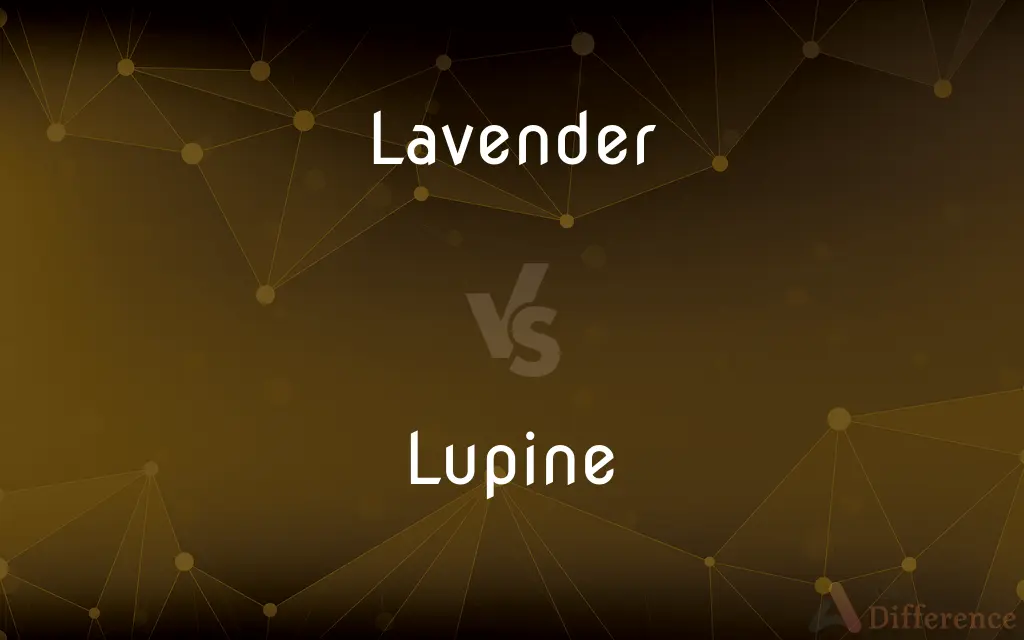Lavender vs. Lupine — What's the Difference?
By Tayyaba Rehman & Maham Liaqat — Updated on April 6, 2024
Lavender is known for its fragrant flowers and essential oils, used in aromatherapy and cosmetics, while lupine, with its vibrant spikes, enriches gardens and fixes nitrogen in soil.

Difference Between Lavender and Lupine
Table of Contents
ADVERTISEMENT
Key Differences
Lavender, a member of the mint family, is celebrated for its soothing fragrance and purple blossoms, which are widely used in aromatherapy, cosmetics, and culinary applications. Its essential oil is prized for its calming and therapeutic properties. On the other hand, lupine, belonging to the legume family, showcases tall, colorful spikes of flowers that not only add beauty to gardens but also play a crucial role in soil health by fixing nitrogen, enriching the earth for other plants.
While lavender thrives in dry, well-drained soils and full sun, adapting well to Mediterranean climates, lupine prefers a wider range of environments, from sandy soils to mountainous regions. This adaptability allows lupines to be a more versatile choice for gardeners in various climates, whereas lavender's requirements can limit its cultivation to specific areas.
Lavender's use extends beyond horticulture into the realms of medicine and lifestyle, leveraging its essential oils for stress relief and sleep aid, signifying its multifaceted applications. Conversely, lupines are often valued more for their aesthetic appeal and environmental benefits, such as enhancing biodiversity and preventing soil erosion, highlighting a more ecological role.
The propagation methods also differ; lavender can be grown from seeds or cuttings, with cuttings being preferred for maintaining specific varieties' characteristics. Lupines, however, are typically grown from seeds, which can self-sow in favorable conditions, leading to naturalized populations that thrive without intensive care.
In culinary use, lavender is utilized for its unique flavor, infusing sweets and savories, while lupine seeds are consumed in some cultures, providing a source of protein. However, it's important to note that certain lupine varieties can be bitter or toxic without proper processing.
ADVERTISEMENT
Comparison Chart
Family
Mint (Lamiaceae)
Legume (Fabaceae)
Uses
Aromatherapy, cosmetics, culinary
Gardening, soil enrichment
Climate Preference
Dry, well-drained soils; Mediterranean climates
Versatile; sandy soils to mountainous regions
Benefits
Calming fragrance, therapeutic properties
Nitrogen fixation, biodiversity enhancement
Propagation
Seeds, cuttings (preferred for variety)
Seeds, often self-sows
Compare with Definitions
Lavender
Utilized in culinary for its unique flavor.
Lavender is often added to desserts for a floral note.
Lupine
A flowering plant known for its colorful spikes.
Lupines add vibrant colors to the garden in spring.
Lavender
Grown for its essential oil, valued in natural remedies.
Lavender essential oil is used in many skincare products.
Lupine
Seeds can be eaten, providing protein.
Lupine seeds are used in some traditional cuisines.
Lavender
Known for its purple flowers and soothing scent.
Lavender fields are a common sight in the Mediterranean.
Lupine
Belongs to the legume family, fixing nitrogen in soil.
Planting lupines can improve garden soil health.
Lavender
A fragrant herb used in aromatherapy and cosmetics.
Lavender oil is popular for its relaxing effects.
Lupine
Benefits include enhancing biodiversity and preventing erosion.
Lupines help maintain the ecological balance in gardens.
Lavender
Requires dry, well-drained soil and full sun.
Lavender thrives in the garden's sunny spot.
Lupine
Versatile in habitat, from sandy soils to mountains.
Lupines are adaptable to various garden conditions.
Lavender
A small aromatic evergreen shrub of the mint family, with narrow leaves and bluish-purple flowers, used in perfumery and medicine.
Lupine
Any of numerous plants of the genus Lupinus of the pea family, having palmately compound leaves and colorful flowers grouped in spikes or racemes. Some species are cultivated as ornamentals and others for their edible seeds.
Lavender
A pale blue colour with a trace of mauve
She wore a lavender silk dress
Romantic designs in old-fashioned tones of primrose, lavender, and rose
Lupine
Characteristic of or resembling a wolf.
Lavender
Perfume with lavender
Lavendered sheets
Lupine
Rapacious; ravenous.
Lavender
Any of various aromatic plants of the genus Lavandula of the mint family, native chiefly to the Mediterranean region, especially L. angustifolia, having clusters of small purplish flowers. Lavender is widely cultivated as an ornamental and for its essential oil, used in perfumery and cosmetics.
Lupine
Of, or pertaining to, the wolf.
Lavender
The fragrant dried leaves, stems, and flowers of this plant.
Lupine
Wolflike; wolfish.
Lavender
A pale to light purple to very light or very pale violet.
Lupine
Having the characteristics of a wolf.
Lavender
Any of a group of European plants, genus, Lavandula, of the mint family.
Lupine
Ravenous.
Lavender
(color) A pale bluish purple colour, like that of the lavender flower.
Lupine
Alternative form of lupin.
Lavender
A kind of film stock for creating positive prints from negatives as part of the process of duplicating the negatives.
Lupine
A leguminous plant of the genus Lupinus, especially Lupinus albus, the seeds of which have been used for food from ancient times. The common species of the Eastern United States is Lupinus perennis. There are many species in California.
Lavender
(color) Having a pale purple colour.
Lupine
Wolfish; ravenous.
Lavender
(politics) Pertaining to LGBT people and rights.
Lupine
Any plant of the genus Lupin; bearing erect spikes of usually purplish-blue flowers
Lavender
(transitive) To decorate or perfume with lavender.
Lupine
Of or relating to or characteristic of wolves
Lavender
An aromatic plant of the genus Lavandula (Lavandula vera), common in the south of Europe. It yields and oil used in medicine and perfumery. The Spike lavender (Lavandula Spica) yields a coarser oil (oil of spike), used in the arts.
Lavender
The pale, purplish color of lavender flowers, paler and more delicate than lilac.
Lavender
Any of various Old World aromatic shrubs or subshrubs with usually mauve or blue flowers; widely cultivated
Lavender
Of a pale purple color
Common Curiosities
What distinguishes lupine in the garden?
Lupine is distinguished by its tall, colorful flower spikes and its ability to fix nitrogen in the soil, improving soil health.
How does lavender benefit the ecosystem?
While primarily known for its use in products, lavender can also support pollinators like bees with its flowers.
What is lavender known for?
Lavender is renowned for its fragrant flowers and essential oils, widely used for their calming and therapeutic properties.
Can lavender be used in cooking?
Yes, lavender is used in culinary applications for its unique flavor, particularly in sweets and some savory dishes.
Are lupines edible?
Lupine seeds are edible and are consumed in some cultures, though some varieties require processing to remove bitterness.
Is it easy to propagate lupines?
Lupines are generally easy to propagate from seeds and can self-sow, making them a low-maintenance option for gardeners.
Can lavender grow in any garden?
Lavender requires specific conditions, such as well-drained soil and full sun, limiting its cultivation to areas with suitable climates.
Can lavender oil help with sleep?
Yes, lavender oil is often used as a natural remedy to improve sleep quality due to its relaxing scent.
What precautions should be taken when eating lupines?
Certain lupine varieties can be bitter or toxic; it's important to choose edible species and process them correctly to avoid toxicity.
Why are lupines important for soil health?
Lupines enrich the soil by fixing nitrogen, making nutrients more available to other plants and improving overall soil fertility.
What are the medicinal uses of lavender?
Lavender is used for its antiseptic and anti-inflammatory properties, in addition to being a popular choice for stress relief and sleep aid.
How do lupines support biodiversity?
By fixing nitrogen and providing habitat and food for various species, lupines play a role in enhancing garden biodiversity.
How does the climate affect lupine growth?
Lupines are adaptable to a wide range of climates, from sandy soils to mountainous areas, making them versatile garden plants.
What part of lavender is used for essential oils?
The flowers of lavender are distilled to produce essential oil, which captures the plant's aromatic and therapeutic qualities.
How do lavender and lupine compare in terms of water needs?
Lavender prefers dry conditions and is drought-tolerant, whereas lupines can adapt to various moisture levels but generally prefer moderately moist soil.
Share Your Discovery

Previous Comparison
Twoonie vs. Toonie
Next Comparison
Spiritual vs. EtherealAuthor Spotlight
Written by
Tayyaba RehmanTayyaba Rehman is a distinguished writer, currently serving as a primary contributor to askdifference.com. As a researcher in semantics and etymology, Tayyaba's passion for the complexity of languages and their distinctions has found a perfect home on the platform. Tayyaba delves into the intricacies of language, distinguishing between commonly confused words and phrases, thereby providing clarity for readers worldwide.
Co-written by
Maham Liaqat















































